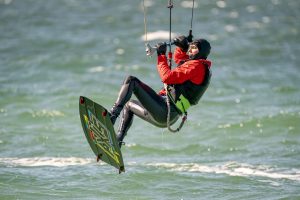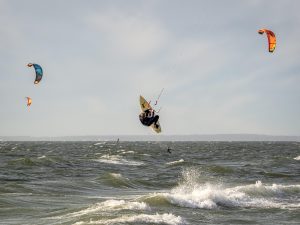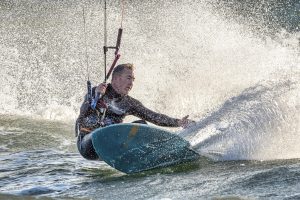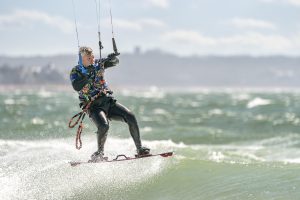By CHRISTOPHER KAZARIAN
When it comes to sports, kiteboarding is still in its infancy. While various forms of it existed in the 1970s and ‘80s, it wasn’t until the late 1990s that it became mainstream.

MONTE LADNER
Dylan Fernandes catches air at Chappy Beach.
Among those to jump onto the kiteboarding craze early on was Paul Miskovsky of Falmouth. He started taking lessons 13 years ago in Waquoit under the watchful eye of George Chahine and Ed White of Sandwich.
“It took me about six months to learn the basics,” he said. “It is a sport that requires you to have some intuition and really pay attention to everything around you.”
The owner of Miskovsky Landscaping, he is one of a growing number of Falmouth residents who have embraced the fledgling sport and who regularly kite off Chapoquoit Beach. They have dubbed themselves the Chappy Kiters.
“There’s about 25 of us. There’s scientists, woodworkers, biologists, doctors, landscapers, policemen, nurses, people from all walks of life,” he said. “Kiteboarding is like an equalizer for all of us. We all have different styles though some are more similar than others. …We’re supportive of one another and there is a lot of camaraderie. It’s like being on a team together, but we’re very independent at the same time.”
As far as excitement goes, kiteboarding is definitely not for the faint of heart. “It’s a thrill-based sport and it can be scary,” Mr. Miskovsky admitted.
Having skateboarded and played hockey for much of his life, he was already familiar with many of its principles when he started kiting. “I picked a lot of it right up, but I fought some of the premises,” he said. “One of the things I tell new guys is to follow your kite. Don’t try to fight your kite. And if you get yourself into trouble, release the kite before you even think so you can stay safe.”
His other tip? Take lessons.

Tim Flynn lifts off among others at Chappy Beach.
Because Cape Cod is a such a hotbed for kiteboarding, there’s a perfect opportunity to do that safely under the watchful eye of Philip Mann, owner of Inland Sea Windsurf Co. in West Dennis. He’s a traditional Cape Codder who has long been connected to the water; he started windsurfing when he was only 13 years old. He picked up kiteboarding in 1998 after watching two pioneers of the sport, Don Montague and Robby Nash, riding in Maui.
“It is an interesting sport in that it is inherently dangerous or can be very dangerous because things happen really quickly and if you’re not trained properly it can go very, very wrong,” he said. “The very first thing people should do is take lessons. It’s not the kind of sport where you buy gear without a lot of thought and go, ‘I’m going to figure this out.’ You’d be better off buying a Cessna and trying to teach yourself how to fly. You’d probably have more success at that than kiteboarding.”
Despite those dangers, there’s something uniquely thrilling about kiteboarding. “I’ve been doing this for 20-something years and I still can’t believe it works. This shouldn’t work. I’m standing on a wakeboard going 25 miles per hour being pulled by a kite,” he said. “You can go wherever you want. You can go upwind, you can go downwind. It is really incredible. You’re in control of everything, sort of, but Mother Nature is telling you your boundaries.”

MONTE LADNER
Ben Stadelmaier is a regular at Chappy Beach.
He recommended anyone interested not try to kiteboard on a whim. “It’s not for people who are just looking for something to do today,” he said. “If they want that, they’re looking to do a whale watch and not looking for an activity that has some anxiety-producing moments that you have to put some time into.”
He estimated that most newcomers need a minimum of six to 10 hours before they can be comfortable on their own.
It can quickly turn into an addiction for people “the first time the kite pulls them along the water,” he said.
As to what makes a good kiter, he said, “you don’t have to be really strong. It’s about being a good pilot. Everything comes down to the basics of being able to fly a good kite. If you put the kite in the wrong spot, it will pull you really hard. The better you get at it, the less effort it takes.”
For beginners, Dennis is a prime location because the water is flat, there is ample room, and the town is accommodating to kiteboarders. Mr. Mann’s shop sells all the equipment needed for the sport—kites; the bar, which is the line that controls the system; boards; harnesses; and pumps to blow up the kite. Wetsuits are optional, depending on the time of year you’re kiting.
It was in Dennis that state Representative Dylan Fernandes first learned how to kiteboard.
He purchased his gear in late 2014 after Maura Healey was elected Massachusetts Attorney General. Mr. Fernandes served as the political director of her campaign.
“I bought it with a bonus after we won the campaign,” he said. “Normally, you would take lessons and figure things out. I went ahead and bought everything up front without even trying the sport.”

MONTE LADNER
Paul Miskovsky found playing hockey helped when he took to the kiteboard.
His impetus for doing so? He had watched other people kiting and became enamored with the visual display of people surfing across the water and flying in the air. “I was like, ‘How do I do that?’ It looked incredible,” he said.
Mr. Fernandes’ first time using his new gear was during a test run in the snow in Western Massachusetts that winter.
“I was at a friend’s place in Amherst and we were snow kiting and we had a couple of snowboards,” he said, laughing that, “Basically, as soon as I put it on, I got launched 10 feet in the air and dragged 50 feet down a field. That’s when I knew I needed some lessons. It was a good realization that this is something you can’t teach yourself, like I had taught myself how to windsurf in Great Harbor in Woods Hole.”
So he made the trek to Mr. Mann’s shop for lessons in the summer of 2015. From there, he said, “it is all just practice. The biggest component of kiteboarding early on is learning how to kite upwind so the wind is constantly at your back.”
Six years later, his passion for the sport has only grown, especially with the events of the past year. “For me, it’s really been an awesome escape from the stress of work and the stress of the pandemic and the stress of isolation,” he said. “Kiteboarding, like most extreme sports, is such a therapeutic experience because you’re living entirely in the moment. You’re not thinking about anything else except the wind speed across the water, the arc of a wave coming at you, or lining up a jump or something like that.”
Both he and Mr. Miskovsky can often be found at Chappy—“It’s not a beginner’s spot,” Fernandes said—where a crowd of onlookers is usually watching in amazement.
“It is a great sport,” Mr. Miskovsky said. “It is not for everybody, but the people who do it sure do love it.”

